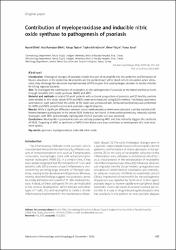| dc.contributor.author | Dilek, Nursel | |
| dc.contributor.author | Dilek, Aziz Ramazan | |
| dc.contributor.author | Taşkın, Yakup | |
| dc.contributor.author | Erkinüresin, Taşkın | |
| dc.contributor.author | Yalçın, Ömer | |
| dc.contributor.author | Saral, Yunus | |
| dc.date.accessioned | 2020-12-19T19:55:56Z | |
| dc.date.available | 2020-12-19T19:55:56Z | |
| dc.date.issued | 2016 | |
| dc.identifier.citation | Dilek, N., Dilek, A. R., Taşkın, Y., Erkinüresin, T., Yalçın, Ö., & Saral, Y. (2016). Contribution of myeloperoxidase and inducible nitric oxide synthase to pathogenesis of psoriasis. Postepy dermatologii i alergologii, 33(6), 435–439. https://doi.org/10.5114/ada.2016.63882 | en_US |
| dc.identifier.issn | 1642-395X | |
| dc.identifier.uri | https://doi.org/10.5114/ada.2016.63882 | |
| dc.identifier.uri | https://hdl.handle.net/11436/2637 | |
| dc.description | YALCIN, OMER T./0000-0001-5626-1881 | en_US |
| dc.description | WOS: 000389786000006 | en_US |
| dc.description | PubMed: 28035220 | en_US |
| dc.description.abstract | Introduction: Histological changes of psoriasis include invasion of neutrophils into the epidermis and formation of Munro abscesses in the epidermis. Neutrophils are the predominant white blood cells in circulation when stimulated; they discharge the abundant myeloperoxidase (MPO) enzyme that uses hydrogen peroxide to oxidize chloride for killing ingested bacteria. Aim: To investigate the contribution of neutrophils to the pathogenesis of psoriasis at the blood and tissue levels through inducible nitric oxide synthase (iNOS) and MPO. Material and methods: A total of 50 adult patients with a chronic plaque form of psoriasis and 25 healthy controls were enrolled to this study. Serum MPO and iNOS levels were measured using ELISA method. Two biopsy specimens were taken in each patient from the center of the lesion and uninvolved skin. Immunohistochemistry was performed for MPO and iNOS on both normal and psoriasis vulgaris biopsies. Results: While a significant difference between serum myeloperoxidase levels were detected, a similar statistical difference between participants in the serum iNOS levels was not found. in immunohistochemistry, intensely stained leukocytes with MPO and intensely staining with iNOS in psoriatic skin was observed. Conclusions: Neutrophils in psoriasis lesions are actively producing MPO and this indirectly triggers the synthesis of iNOS. Targeting of MPO or synthesis of MPO in the lesion area may contribute to development of a new treatment option. | en_US |
| dc.language.iso | eng | en_US |
| dc.publisher | Termedia Publishing House Ltd | en_US |
| dc.rights | info:eu-repo/semantics/openAccess | en_US |
| dc.subject | Psoriasis | en_US |
| dc.subject | Myeloperoxidase | en_US |
| dc.subject | Inducible nitric oxide | en_US |
| dc.title | Contribution of myeloperoxidase and inducible nitric oxide synthase to pathogenesis of psoriasis | en_US |
| dc.type | article | en_US |
| dc.contributor.department | RTEÜ, Tıp Fakültesi, Dahili Tıp Bilimleri Bölümü | en_US |
| dc.contributor.institutionauthor | Dilek, Nursel | |
| dc.contributor.institutionauthor | Dilek, Aziz Ramazan | |
| dc.contributor.institutionauthor | Saral, Yunus | |
| dc.identifier.doi | 10.5114/ada.2016.63882 | |
| dc.identifier.volume | 33 | en_US |
| dc.identifier.issue | 6 | en_US |
| dc.identifier.startpage | 435 | en_US |
| dc.identifier.endpage | 439 | en_US |
| dc.ri.edit | oa | en_US |
| dc.relation.journal | Postepy Dermatologii I Alergologii | en_US |
| dc.relation.publicationcategory | Makale - Uluslararası Hakemli Dergi - Kurum Öğretim Elemanı | en_US |


















